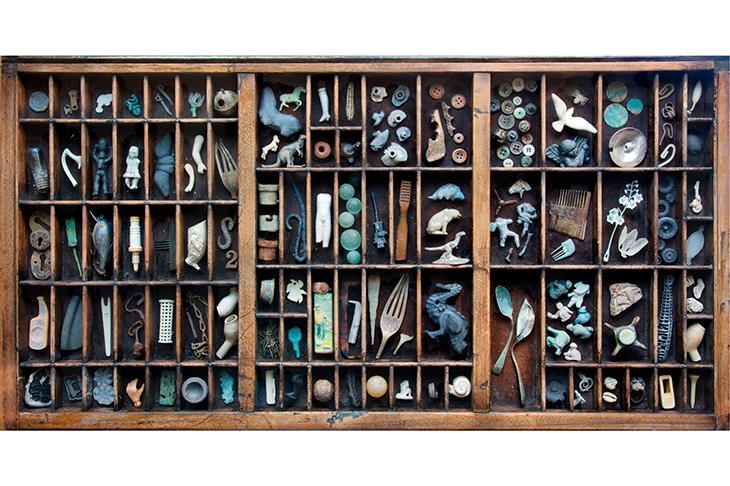All it takes to turn a cast-off into a prized possession can be a bit of imagination. To a passerby, a bookcase left on the pavement might be perfect for that impossible-to-furnish alcove. An empty bottle, once the waves have worn it smooth, could become a precious jewel for a beachcomber. In an instant a bored child will fish a piece of cardboard from the bin and transform it into a rocket, raft or portal to another dimension. One man’s rubbish, as we know, is another man’s treasure.
The subject is explored in Rag and Bone by the photographer Lisa Woollett, who has a personal connection with discards. Her grandfather was a dustman and her great-grandfather a professional scavenger on the Thames foreshore. Taking us on a series of walks beside the tideline, beginning in central London and moving towards the estuary where she grew up, Woollett pulls abandoned objects from the mud and brings their stories to the surface.
Buttons, pipes, inkwells and bones join her burgeoning collection, and feature in the meticulous photographic collages that illustrate the book. This recreational mudlarking has received considerable publicity recently: enthusiasts have built significant Instagram followings with artfully posed pictures of their finds, and the Thames sections of Rag and Bone have much in common with Lara Maiklem’s book on the subject published last year.
Woollett has now left London for Cornwall, and a somewhat disjointed finale sees her picking up Lego bricks and micro-plastic beads on the sand there. Her environmental worries are well handled; but without the earlier geographical framework the narrative loses its urgency. This kind of book aims to meld disparate elements into a whole — family and urban history, nature writing, psychogeography and ecology — but it doesn’t quite come off here.
Emily Cockayne’s Rummage overflows with detail. She rescues wonderfully bizarre artefacts from rubbish heaps to plot Britain’s changing attitudes to consumption and recycling. There are pianos made from blood and sawdust, bed socks from dog hair, a book from a ship, and much else.
She takes in the make-do-and-mend mentality of the second world war, and discusses why so much recycling work has traditionally fallen to women. Nowadays it has become more of a middle-class preoccupation, for those with the time to sort different kinds of paper and make special trips for their disposal. But there’s nothing worthy about Cockayne, and the way she embraces historical anecdote, social critique and personal reminiscence never seems ponderous.
It’s hard not to fall for a chapter on stuffed animals which begins: ‘In 1983 my nan gave me a toy lion which smelt of feet.’ On the next page there’s a photograph of a cuddly Womble that has been disembowelled to reveal its components — a clue to the unemotional way Cockayne handles her material. Who’d have thought that a trawl through jumble sales could be quite so engaging?
The ‘bottom up’ view of history grows ever more popular as we investigate how our forebears scraped their livings. Cockayne extends this to ‘things previously deemed irrelevant or commonplace’. By breaking down the boundaries between waste and overlooked treasure, Rummage will make us think twice about what we throw away in future.






Comments